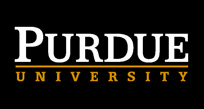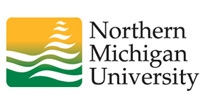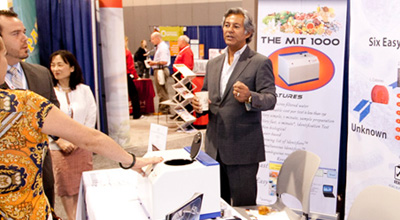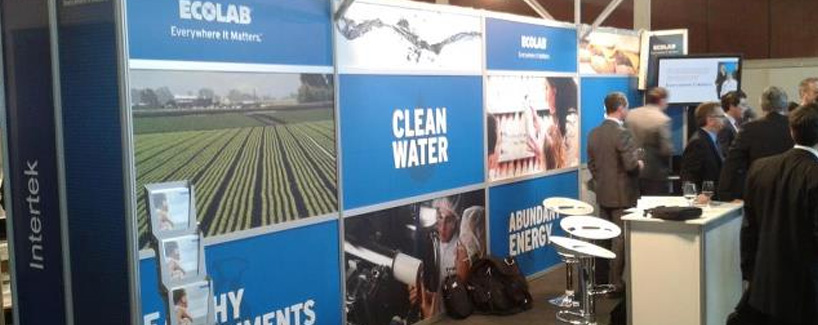MIT Blog
Purdue University - Micro Imaging Technology Strategic Research on Rapid Detection of Pathogens

San Clemente, CA. October 1, 2013....Micro Imaging Technology, Inc. (OTCQB: MMTC) announced today a strategic research collaboration with Purdue University to prove the concept of faster, cheaper, and easier pathogen testing for Listeria and Listeria monocytogenes in foods using laser light scattering. The partnership pairs similar laser light scattering technologies developed independently by each contributor to demonstrate the speed and accuracy of using non-biological methods to provide a simple, rapid, and cost-effective solution to food pathogen testing.
Dr. Arun Bhunia, BVSc, PhD, Professor of Food Microbiology at the Purdue University Department of Food Science, will direct the Purdue portion of the research together with Dr. Euiwon Bae, a mechanical engineer, at his facilities in West Lafayette, IN. Prof. Bhunia received his Ph.D. in Food Microbiology at the University of Wyoming. A recent recipient of Purdue’s Outstanding Graduate Educator (College of Agriculture), Dr. Bhunia’s research has focused on the development of novel detection and diagnostic tools for food borne pathogens employing optical and electrical biosensors, including light scattering based sensors. Dr. Bhunia’s group developed Purdue’s BARDOT (Bacterial Rapid Detection using Optical scattering Technology,) a colony-based bacterial screening system that very rapidly scans and detects pathogens on culture plates.
Micro Imaging Technology’s Chief Scientist, Dr. David Haavig, is the Program Director of the effort and also will lead MIT’s efforts in the collaboration. Coincidentally, he received his Ph.D. in Physics from Purdue University in 1983. Dr. Haavig was instrumental in developing the MIT 1000, a bacterial cell based identification system that can identify pathogenic bacteria in three (3) minutes (average) at significant cost savings per test. “The synergy of these two systems for independent detection (BARDOT) and confirmation (MIT 1000) of the presence of pathogens in food is fantastic. This is a win-win program,” Dr. Haavig remarked. “It benefits MIT, Purdue and its students, as well as the entirety of the food industry and consumers worldwide. We cannot be more pleased to be working with Dr. Bhunia and his staff.”
About: Purdue University
Purdue University is a major education and research institution known for discoveries in science, technology, engineering, math and beyond. Founded in 1869 in West Lafayette, Indiana, the University proudly serves its state as well as the nation and the world. More than 39,000 students from all 50 states and 130 countries, along with some 850 student organizations and Big Ten Boilermaker athletics, make for a lively environment.
About: Micro Imaging Technology, Inc.
Micro Imaging Technology, Inc. is a California-based public company that is also registered to do business under the name Micro Identification Technologies. MIT has developed and patented the MIT 1000, a stand-alone, rapid, optically-based, software driven system that can identify pathogenic bacteria and complete an identification test, after culturing, in three (3) minutes (average) at the lowest cost per test when compared to any other conventional method. It does not rely on chemical or biological agents, conventional processing, fluorescent tags, gas chromatography or DNA analysis. The process requires only clean filtered water and a sample of the unknown bacteria. Revenues for all rapid testing methods exceed $5 billion annually – with food safety accounting for over $3.5 billion, which is expected to surpass $4.7 billion by 2015 according to BCC Research. In addition, the recently passed “New” U.S. Food Safety Bill is expected to further accelerate the current annual growth rate of 6.6 percent.
In June 2009, the AOAC Research Institute (AOAC RI) awarded the Company Performance Tested Methods SM (PTM) certification for the rapid identification of Listeria. The AOAC RI provides an independent third party evaluation and expert reviews of methods and will award PTM certification to methods that demonstrate performance levels equivalent or better than other certified bacteria identifying methods. The MIT System underwent hundreds of individual tests, including ruggedness and accuracy, to earn AOAC RI’s certification for the identification of Listeria.
You can find more information about our company and about Micro Identification TechnologiesTM. Please visit our newly enhanced website at www.micro-identification.com.
Northern Michigan University and Micro Imaging Technology to Collaborate on Rapid Detection of Staph and MRSA Pathogens

SAN CLEMENTE, CA--(Marketwired - Oct 25, 2013) - Micro Imaging Technology, Inc. (OTCQB: MMTC) announced today that it will collaborate with the Northern Michigan University (NMU) Department of Biology to expand MIT's technology to identify and differentiate Staphylococcus aureus (S. aureus) and Methicillin Resistant Staphylococcus aureus (MRSA). The goal of the strategic research with NMU is to rapidly and cost-effectively identify these two particular healthcare threats using the MIT 1000 System, a bacterial cell based identification system that can identify pathogenic bacteria in three minutes (average) at significant cost savings per test.
At this stage the collaboration involves scientists from MIT and NMU gathering preliminary data and developing collaborative research proposals seeking funding in support of continued research.
Dr. Josh S. Sharp, Ph.D., assistant professor at the Northern Michigan University Department of Biology, will direct the NMU portion of the research at his laboratory in Marquette, MI. Sharp received a B.S. at Western Michigan University in 1998 and his Ph.D. in Biological Sciences at the Mount Sinai School of Medicine of New York University in 2006. His initial research in this collaboration will focus on clinical applications of the MIT 1000.
"Being able to quickly identify if a patient has an S. aureus infection, and whether or not that S. aureus is MRSA, a strain of S. aureus resistant to certain antibiotics would be extremely useful in dictating the proper course of treatment for that patient, and ultimately increase the likelihood of a successful patient outcome," Sharp said.
Micro Imaging Technology's Chief Scientist, Dr. David Haavig, is the program director of the effort and will lead MIT's team in the collaboration. He received his Ph.D. in Physics from Purdue University in 1983. Haavig was instrumental in developing the MIT 1000, a stand-alone, rapid laser based bacteria detection and identification technology that can detect pathogenic bacteria and complete an identifying test in less than three minutes (average) at significant cost savings per test.
"We are extremely pleased to be working with Dr. Sharp and his staff on this project," Haavig said. "We are confident that this collaborative effort will be highly successful and the result of our teamwork and the clinical implications for this technology may very well prove to be immeasurable."
About: Northern Michigan University
Northern Michigan University, located in Marquette, Michigan, is a dynamic four-year, public, coeducational university that has grown its reputation based on its award-winning leadership programs, cutting-edge technology initiatives and nationally recognized academic programs. The university's fastest growing academic areas are clinical science, biology, and the geographical and environmental sciences. Northern Michigan has a population of about 9,200 undergraduate and graduate students. It offers 180 degree programs, including 18 graduate programs.
About: Micro Imaging Technology, Inc.
Micro Imaging Technology, Inc. is a California-based public company that is also registered to do business under the name Micro Identification Technologies. MIT has developed and patented the MIT 1000, a stand-alone, rapid, optically-based, software driven system that can identify pathogenic bacteria and complete an identification test, after culturing, in three minutes (average) at the lowest cost per test when compared to any other conventional method. It does not rely on chemical or biological agents, conventional processing, fluorescent tags, gas chromatography or DNA analysis. The process requires only clean filtered water and a sample of the unknown bacteria. Revenues for all rapid testing methods exceed $5 billion annually -- with food safety accounting for more than $3.5 billion, which is expected to surpass $4.7 billion by 2015 according to BCC Research. In addition, the recently passed "New" U.S. Food Safety Bill is expected to further accelerate the current annual growth rate of 6.6 percent.
In June 2009, the AOAC Research Institute (AOAC RI) awarded the Company Performance Tested Methods SM (PTM) certification for the rapid identification of Listeria. The AOAC RI provides an independent third party evaluation and expert reviews of methods and will award PTM certification to methods that demonstrate performance levels equivalent or better than other certified bacteria identifying methods. The MIT System underwent hundreds of individual tests, including ruggedness and accuracy, to earn AOAC RI's certification for the identification of Listeria.
You can find more information about our company and about Micro Identification Technologies(TM) . Please visit our newly enhanced website at www.micro-identification.com.
This release contains statements that are forward-looking in nature. Statements that are predictive in nature, that depend upon or refer to future events or conditions or that include words such as "expects," "anticipates," "intends," "plans," "believes," "estimates," and similar expressions are forward-looking statements. These statements are made based upon information available to the Company as of the date of this release, and we assume no obligation to update any such forward-looking statements. These statements are not guarantees of future performance and actual results could differ materially from our current expectations. Factors that could cause or contribute to such differences include, but are not limited to dependence on suppliers; short product life cycles and reductions in unit selling prices; delays in development or shipment of new products; lack of market acceptance of our new products or services; inability to continue to develop competitive new products and services on a timely basis; introduction of new products or services by major competitors; our ability to attract and retain qualified employees; inability to expand our operations to support increased growth; and declining economic conditions, including a recession. These and other factors and risks associated with our business are discussed from time to time within our filings with the Securities and Exchange Commission, reference MMTC: www.sec.gov.
MRSA Statistics

Reducing methicillin-resistant Staphylococcus aureus (MRSA) in both healthcare and community settings continues to be a high priority for the CDC. The agency is engaged in several short- and long-term surveillance (infection tracking) projects that involve collaboration with partners including health departments, individual hospitals, and academic medical centers, among others. Understanding the burden of MRSA – how much is occurring, where it is happening, and how it is being spread – is essential for developing effective prevention programs and measuring their impact.
In 2010, encouraging results from a CDC study published in the Journal of the American Medical AssociationExternal Web Site Icon showed that invasive (life-threatening) MRSA infections in healthcare settings are declining. Invasive MRSA infections that began in hospitals declined 28% from 2005 through 2008. Decreases in infection rates were even bigger for patients with bloodstream infections. In addition, the study showed a 17% drop in invasive MRSA infections that were diagnosed before hospital admissions (community onset) in people with recent exposures to healthcare settings.
This study (or report) complements data from the National Healthcare Safety Network (NHSN) that found rates of MRSA bloodstream infections occurring in hospitalized patients fell nearly 50% from 1997 to 2007.
Taken together and with other reports such as the March 2011 CDC Vital Signs article, these studies provide evidence that rates of invasive MRSA infections in the United States are falling. While MRSA remains an important public health problem and more remains to be done to further decrease risks of developing these infections, this decrease in healthcare-associated MRSA infections is encouraging.
MRSA in the community (people without recent close contact with the healthcare system) typically shows up as infections of the skin. Rates of these infections increased rapidly during the past decade and there is little evidence that the risk of developing community MRSA is following the same downward trend as healthcare-associated infections. Although the majority of these infections are treated without long-term issues, CDC is working to prevent MRSA in the community.
Reprinted from www.cdc.gov.
Read More - http://www.cdc.gov/mrsa/statistics/index.html
Challenges and Innovations for On-Farm Bacterial Testing

By Amanda Kinchla, M.Sc., and Sam Nugen, Ph.D.
Each year, an estimated 47.8 million people in the U.S. will become ill from eating contaminated foods.[1] A study by the U.S. Centers for Disease Control and Prevention has recently concluded that leafy greens are responsible for almost half of these foodborne illnesses.[2] Foodborne outbreaks associated with produce have increased significantly, from 0.7 percent in the 1970s to 13 percent between 1990 and 2005.[3] From 1990 to 2005, there have been 713 recorded produce-related outbreaks and approximately 34,000 cases of illness associated with produce contamination.[3]
While demand has been growing for the consumption of fresh produce for better health and nutrition, at present, a pragmatic nonthermal process to reduce pathogenic risk in produce has not been put into practice. Food safety has continued to grow in importance, and the climate is changing to demand that stronger food safety programs are instituted throughout the food chain from farm to fork. Under the newly established Food Safety Modernization Act (FSMA), the U.S. Food and Drug Administration (FDA) will now have regulations for produce.[4] These regulations emphasize employee training, health and hygiene, agricultural water, biological soil amendments of animal origin, domesticated and wild animals, equipment, tools and buildings.[5]
Farmers will soon be responsible for validating the food safety of their on-farm water and soil. Part of the proposed ruling is to have agricultural water tested routinely to ensure that the water source is safe for its intended on-farm use. If the tested water fails the declared compliance, certain actions must be taken to make it safe (proposed sections 112.44 and 112.45). While these activities are intended to support the reduction of foodborne pathogens within produce, they will have a significant impact on many farmers’ methods of growing produce.
Current microbiological methods traditionally take between 24 and 72 hours to complete, plus the time it takes to send the sample to the laboratory for testing. In the operational process of produce, harvested product is shipped to distribution centers or sent directly to stores within 1 to 3 days to ensure the best quality and maintain that quality for at least 7 to 10 days. Adding more time to account for microbiological testing could be detrimental to overall product quality. Besides the time it takes to conduct testing, there are significant costs associated as well. The general cost to outsource a 100-mL water sample for an Escherichia coli/coliform assay to a microbiological lab ranges from $15 to $28 per sample. Due to the complexity of the test, currently this is the only option available for farmers.
During one of the most recent Q&A calls for the Produce Safety Alliance in regard to the Produce Safety Rules, many farmers expressed great concern about the proposed rulings for agricultural water. Farmers are very worried about how they will manage product if their water sampling results return out of regulatory compliance. One farmer pointed out that if he pulls a water sample on Monday, he would likely not get the results until Friday. The proposed rules require that you treat the water to ensure that the source is deemed safe; however, they don’t provide guidance on how to manage the produce that has been exposed to the contaminated water between Monday and Thursday. Although it is prudent that all contributors be involved in food safety, this issue illustrates a need for better on-farm tools to meet the upcoming food safety expectations.
While the current laws exempt small farms from mandated food safety plans such as a Good Agricultural Practices (GAP) certification, the climate is changing. Many wholesale and chain grocery buyers, such as Hannaford and Price Chopper, are requiring that their buyers have a GAP certification to reduce their business liability. Therefore, exempt farms that are not compliant to GAP certification may be at a significant competitive disadvantage if they do not initiate a food safety plan.
Read More at http://www.foodsafetymagazine.com/magazine-archive1/augustseptember-2013...
MIT at the 2013 IAFP Annual Meeting

2013 IAFP Annual Meeting
Each year, the International Association for Food Protection hosts an Annual Meeting, providing attendees with information on current and emerging food safety issues, the latest science, innovative solutions to new and recurring problems, and the opportunity to network with thousands of food safety professionals from around the globe. Held in various locations throughout North America, this meeting has grown over the years to become the leading food safety conference worldwide.
The IAFP Annual Meeting is attended by more than 2,500 of the top industry, academic and governmental food safety professionals from six continents. This renowned event owes its reputation and success to the quantity, quality and diversity of each year’s program; the quality and relevance of exhibits sharing the latest in available technologies; leading experts speaking on a variety of timely topics; and special recognition of outstanding professionals and students for their contributions in the food safety field.
IAFP 2013
July 28-31 (Sunday - Wednesday)
Charlotte Convention Center
Charlotte, North Carolina
MIT at Food Safety Summit

San Clemente, CA. April 24, 2013....Micro Imaging Technology, Inc. (OTCQB: MMTC) announced that it will attend this year’s Food Safety Summit Conference and exhibit the MIT 1000 in Baltimore, Maryland - April 30 through May 2, 2013. Now in its 15th year, the Food Safety Summit provides important food safety information and solutions to those responsible for assuring food safety across the food supply chain.
The Food Safety Summit is a solutions-based conference and expo designed to meet the educational and information needs of the entire food industry including growers, processors, retailers, distributors, foodservice operators, regulators and academia. “We will continue to showcase the MIT 1000 to the Food Safety Industry through these events,” stated Jeff Nunez, MIT’s Chairman and CEO. “Our primary objective, dedication, and commitment, however, is to the development of additional ‘Identifiers.’ In the meantime, it is important that we continue to expose the Food Safety Industry and begin showing the Clinical Industry the speed, ease of use, accuracy, and low cost of the MIT 1000 System, which can be commercially used today for the pathogenic testing of Listeria species.”
The MIT 1000 is a stand-alone, rapid laser based bacteria detection and identification technology; a software driven system that can detect pathogenic bacteria and complete an identifying test in under three (3) minutes (average) at significant cost savings per test. In June 2009, the AOAC Research Institute (AOAC RI) awarded the Company Performance Tested Methods SM (PTM) certification for the rapid identification of Listeria. The AOAC RI provides an independent third party evaluation and expert reviews of methods and will award PTM certification to methods that demonstrate performance levels equivalent or better than other certified bacteria identifying methods. The MIT System underwent hundreds of individual tests, including ruggedness and accuracy, to earn AOAC RI’s certification for the identification of Listeria.
Micro Imaging Technology, Inc. is a California-based public company that is also registered to do business under the name Micro Identification Technologies. MIT has developed and patented the MIT-1000, a stand-alone, optically-based, software driven system that can detect pathogenic bacteria and complete an identification test, after culturing, in less than three (3) minutes (average) at the lowest cost per test when compared to any other conventional method. It does not rely on chemical or biological agents, conventional processing, fluorescent tags, gas chromatography or DNA analysis. The process requires only clean particle-free water and a sample of the unknown bacteria. Revenues for all rapid testing methods exceed $5 billion annually – with food safety accounting for over $3.5 billion, which is expected to surpass $4.7 billion by 2015 according to BCC Research. In addition, the recently passed “New” U.S. Food Safety Bill is expected to further accelerate the current annual growth rate of 6.6 percent.
Processing Aids Used to Deliver Food Safety

When an expert like James Marsden, Distinguished Regents Professor of Food Science at Kansas State University, starts talking about processing aids, it’s as if a menu of choices pops up in his head. The professor is best known for his work on reducing Shiga Toxin-producing Escherichia coli in beef, so he’s very familiar with the intervention methods that achieve this.
But in going down the list of processing aids that might be used to eliminate E. coli before it can reach consumers, it’s clear there are some choices that would be wiser for producers than others.
“While the very definition of a processing aid is a substance used in food production that are not present in any concerning amount in the end product, they are not always without controversy. Two that come to mind are the industrial-like ammonia process used by Beef Products Inc. to make its lean finely textured beef that the public came to know as ‘pink slime’ and the transglutaminase powder known as ‘meat glue.’”
The USDA has a zero-tolerance policy for seven strains of E. coli.
“It’s very hard to achieve that,” says Marsden.
But one thing that helps producers in this effort is processing aids.
Both the U.S. Food and Drug Administration and the U.S. Department of Agriculture approve processing aids for foods ranging from meat and poultry to other food products. They are not supposed to change the appearance or taste of the product in any way and, more importantly, they cannot negatively impact food safety or public health.
Anything added to food, including processing agents, is regulated as a food additive. That means the processing agent must be “generally recognized as safe,” or GRAS, in order to be approved for use in foods. Food additives and processing agents are either on the GRAS list because of their history of safety, or because companies who use them have gone though scientific processes to prove their safety.
Processing aids are not considered ingredients, however, and therefore are not required to be listed on ingredient lists on nutrition labels.
Both agencies recognize three types of processing aids: those that are used and removed, those that are converted into components that naturally occur at insignificant levels without changing the finished product, and some that remain in food at low levels without any technical or functional effect.
Not all processing aids are as complicated as BPI’s ammonia process or transglutaminase. Take hot water and steam, for example. Thermal processing of beef carcasses using hot water and/or steam is a processing aid that’s been highly effective in reducing E. coli O157:H7 and other pathogens, according to Janet Riley at the American Meat Institute. Hot water and steam leave no residues and have no lasting effect on the product.
Marsden says the use of high-pressure washes in ready-to-eat lunchmeats and hot dogs have virtually eliminated Listeria monocytogenes, the bacterium that causes the infection listeriosis, in these products. As recently as the late 1980s, Listeria contamination seemed to some to be an insolvable problem for the ready-to-eat products.
Killing antimicrobials is just one of the functions processing aids play during the food production process. Others include removing impurities, preventing crystallization, controlling pH levels, controlling bacteria in chill water, scalding agents that remove feathers, and others.
Not every solution can be applied to every product, however. For example, restrictions on Kosher and Halal meats dictate that thermal processes cannot be used. And processing aids that are effective on one pathogen strain might not work on another. That’s something Marsden is dealing with now, as there are six strains of E. coli that have recently been banned from beef, in addition to E. coli O157:H7, which has been banned since 1993.
Only insignificant amounts at safe levels should remain in the food once a processing agent is used, but Marsden says food companies must be aware of how the consumers view chemicals.
Some the public accept without a second thought, such as using lemon juice, vinegar or citric acid, which have not raised consumer concern.